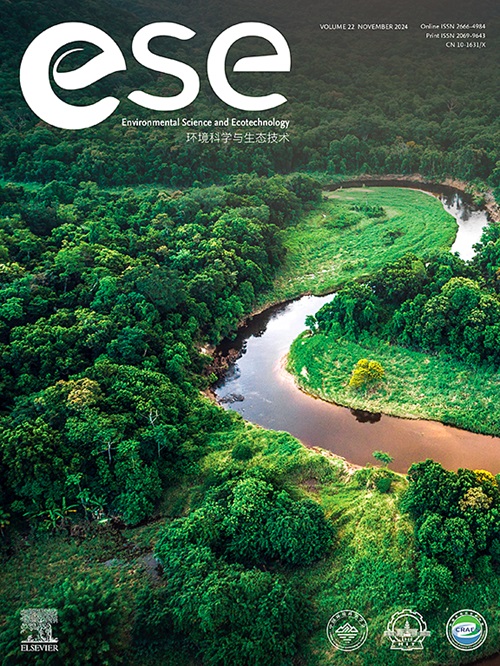Microplastic pollution threatens mangrove carbon sequestration capacity
IF 14
1区 环境科学与生态学
Q1 ENVIRONMENTAL SCIENCES
引用次数: 0
Abstract
Microplastics are a pervasive environmental pollutant, altering microbial communities and disrupting global biogeochemical cycles. Mangrove forests, critical blue carbon habitats, are significant sinks for microplastic accumulation, yet they also cycle large amounts of methane, a potent greenhouse gas. The effect of plastic pollution on methane dynamics in these vital habitats remains, however, poorly understood. Here we show that microplastic pollution in mangrove soils is linked to an increased potential for methane production by favouring methanogenic archaea. Through a nationwide survey of Chinese mangroves, we found that microplastic concentrations were higher (6516 ± 1725 particles kg−1) in surface soils (0–20 cm) and exhibited stronger association with methane-cycling microbes (four linkage pathways), compared to concentrations (2246 ± 497 particles kg−1) and two linkage pathways in deeper soils (20–40 cm). Microplastics in topsoil were correlated with more complex microbial networks, consisting of 150 nodes and 237 links, relative to 113 nodes and 196 links in deeper soils. Furthermore, we directly linked elevated microplastic pollution in surface soils to secondary industry output, which positively correlated with the methanogens-to-methanotrophs gene ratio, establishing a clear anthropogenic driver for this shift. These findings reveal a critical, previously unrecognized mechanism by which industrial plastic pollution may compromise the net carbon sequestration capacity of mangrove ecosystems. Mitigating microplastic discharge is therefore not only a waste management issue but is also essential for preserving the climate-regulating function of these crucial habitats amid global conservation efforts.

微塑料污染威胁着红树林的固碳能力
微塑料是一种普遍存在的环境污染物,改变了微生物群落,破坏了全球生物地球化学循环。红树林是关键的蓝碳栖息地,是微塑料积累的重要汇,但它们也循环大量的甲烷,一种强有力的温室气体。然而,塑料污染对这些重要栖息地甲烷动态的影响仍然知之甚少。在这里,我们表明,红树林土壤中的微塑料污染有利于产甲烷古菌,从而增加了甲烷生产的潜力。通过对中国红树林的全国性调查,我们发现,与深层土壤(20-40 cm)的浓度(2246±497颗粒kg - 1)和两个连锁途径相比,表层土壤(0-20 cm)的微塑料浓度(6516±1725颗粒kg - 1)更高,与甲烷循环微生物(4个连锁途径)的关联更强。表层土壤中的微塑料与更复杂的微生物网络相关,包括150个节点和237个链接,而深层土壤中的微塑料网络由113个节点和196个链接组成。此外,我们将表层土壤微塑料污染的升高与第二产业产出直接联系起来,这与产甲烷菌与产甲烷菌的基因比例呈正相关,从而明确了这一转变的人为驱动因素。这些发现揭示了一个关键的、以前未被认识到的机制,通过这个机制,工业塑料污染可能会损害红树林生态系统的净固碳能力。因此,减少微塑料排放不仅是一个废物管理问题,而且对于在全球保护努力中保持这些重要栖息地的气候调节功能也至关重要。
本文章由计算机程序翻译,如有差异,请以英文原文为准。
求助全文
约1分钟内获得全文
求助全文
来源期刊

Environmental Science and Ecotechnology
Multiple-
CiteScore
20.40
自引率
6.30%
发文量
11
审稿时长
18 days
期刊介绍:
Environmental Science & Ecotechnology (ESE) is an international, open-access journal publishing original research in environmental science, engineering, ecotechnology, and related fields. Authors publishing in ESE can immediately, permanently, and freely share their work. They have license options and retain copyright. Published by Elsevier, ESE is co-organized by the Chinese Society for Environmental Sciences, Harbin Institute of Technology, and the Chinese Research Academy of Environmental Sciences, under the supervision of the China Association for Science and Technology.
 求助内容:
求助内容: 应助结果提醒方式:
应助结果提醒方式:


